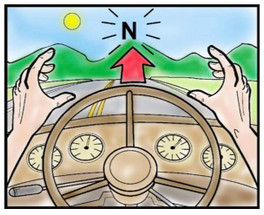
Steering returnability
Steering Returnability
Ever since your first car, you probably became accustomed to turning a corner, then letting the steering wheel slip through your hands as it returned to center and the car continued in a straight path. This is what we call “steering returnability”, and if the steering and alignment in your coach is correct, this is how the steering should respond. If, however, you turn a corner and the coach wants to continue turning instead of straightening itself out, then there is problem that must be addressed.
Like other handling issues, poor steering returnability can have many causes, and sometimes, several components conspire to create the issue. That is why it is important to first diagnose the problem, then take a systematic approach to solving it.
Typically, poor steering returnability is caused by steering gear that is too tight or improperly adjusted. If the steering sector is over-tightened, it causes the sector shaft to put too much pressure against the worm gear. This can occur when a technician at either the factory or a shop attempts to remove excess play from the steering system. Sticking or binding components, such as a king pin, ball joint, bell crank or even the steering column can prevent the steering wheel from returning to center after a turn. Alignment can also be a factor; improper caster, and to some degree, improper toe-in, can be contributing factors.
Apart from always having to manually turn the steering wheel to center after making a turn, poor returnability also means constant lane correction, which adds to driver discomfort and fatigue. So, another way we diagnose returnability is through what we call a “flick test”. As we drive the vehicle down the road in our Road Performance Assessment, we “flick” the wheel to the right and see if the coach continues going to the right—if it does, then we know that the coach requires constant lane correction.
The first step to curing a returnability problem is to trace down what component or components is causing it. What we’ll typically do first is determine if there is anything sticking, and to do that, we literally start at the steering wheel and work our way down. Often, we’ll disconnect components along the way to isolate them from the rest of the system. For example, we may disconnect the pitman arm from the steering gear to see if it’s the steering gear, or if it’s a Freightliner bell crank, we’ll take the support arm loose using our own puller to see if the bell crank is sticking, binding or notchy. On other vehicles, we’ll jack the front axle up, move the wheels side to side, and see if we have binding in the steering linkage, ball joints or king pin. If there is binding at that point, we’ll disconnect individual tie rods from either side to find out which side is sticky.
If nothing appears to be binding or sticking, we then check the wheel alignment and see where the caster and toe are set. It may seem counterintuitive to check the alignment after the components, but if anything is worn out, it must be replaced before it can be properly aligned. If we’re increasing caster on a straight axle vehicle we recommend a steel caster wedge. The caster wedge is installed between the spring and axle, and effectively increases caster angle. We recommend steel wedges because aluminum and pot metal wedges can loosen up over time as they get beaten down from the weight of the coach.
Models with independent front ends can sometimes present a problem because we can run out of caster adjustment. In some instances, we can install an aftermarket steering control such as the Safe-T-Plus, which will help keep the steering center; in others, we may have to delve deeper into the steering system to determine the problem.
In any case, there is no need to live with returnability issues. With proper diagnosis, necessary correction and good alignment, your coach can steer straight and true, and you can sit back and enjoy safer and happier driving!
To learn more about STEERING PLAY issues read over our common RV problems section.
